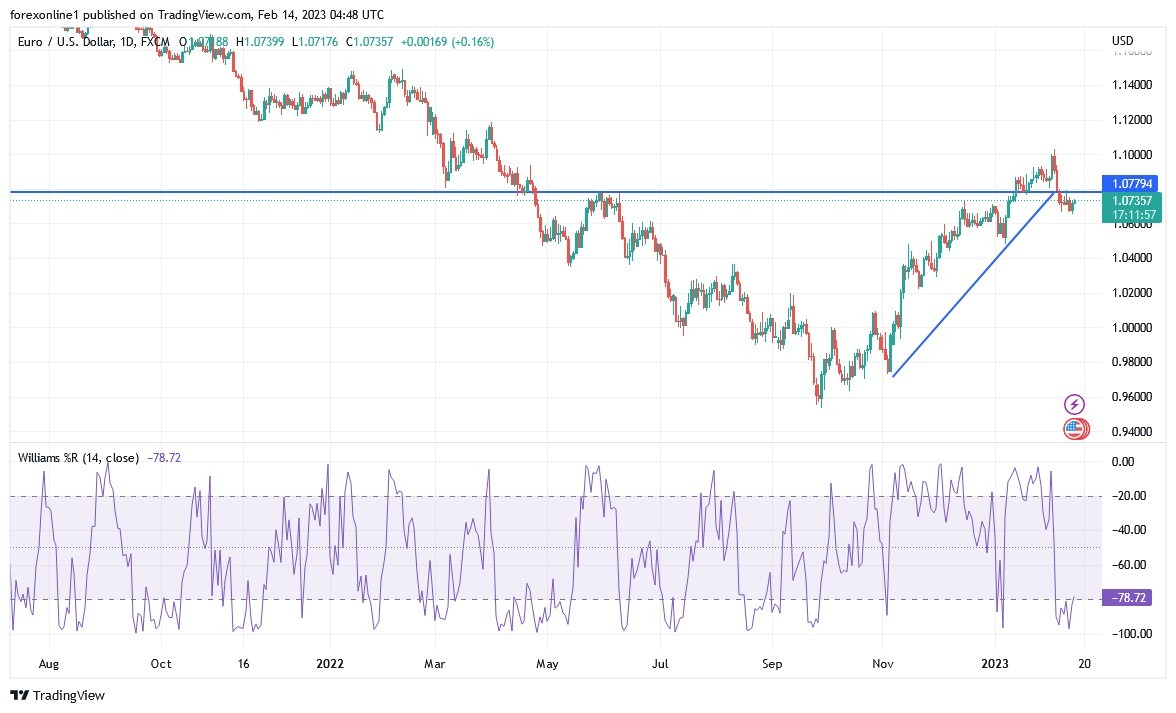EUR/USD gave up much of its gains in January in recent trades and is likely to risk a pullback towards support 1.05 this week. This can happen if a level close to technical support around 1.0679 comes out in a busy period for European and US economic data.
At the beginning of this week's trading, the price of the euro currency pair against the US dollar, EUR/USD, stabilized in a narrow range, with a bearish tendency, between the support level 1.0655 and the level of 1.0715, which is stable around it at the time of writing the analysis.
The performance of the single European currency - the euro - was lower than the performance of all major currencies in the week until Monday. This included the US dollar in general, after economic figures and other developments in third-party markets led to the rise of other currencies outside the euro at the expense of the single European currency.
It should be noted that the Swedish krona, the Norwegian krone, and the pound sterling all found reasons for encouragement in some of the recent economic data and monetary policy developments, while profit-taking in the “long” purchases that were very popular in the euro seemed to have a significant impact on the price of the euro against EUR/USD.
Commenting on the performance, Valentin Marinov, Forex Analyst at Credit Agricole CIB, says: “We have recently highlighted the fact that the Euro has become overbought and overvalued, and this has contributed to its poor performance, especially against the British pound, the Norwegian kroner and the Swedish krona.” . "On the day, the focus will be on the updated EU economic outlook from the European Commission as well as a speech from Mario Centeno from the European Central Bank," he added. We believe that evidence that the European official outlook remains very weak due in part to continued tightening of financial data may keep the euro on the defensive across the board.”
In general, the euro/dollar entered the new week's trading to test the Fibonacci support level at 1.0679, and it will risk more losses to take it below that this week if data on Tuesday showed that the euro-zone economy is weaker than expected, and if the US data calls into question about the idea of reducing inflation. Brad Bechtel, forex analyst at Jefferies, wrote in a market commentary on Friday: “EUR/USD opens in New York near 1.0698 and is still hanging at 50 but I think that will drop soon enough. We will be down around 1.0500 before you know it,” and “BBDXY held a major pivot as well to confirm the underlying strength in the US dollar and several other pairs are poised for a higher US dollar as well. / dollars and a host of others.”
Overall, US inflation figures on Tuesday are the highlights of the week for global markets, but they are preceded by the release of Eurostat's preliminary estimates of eurozone GDP growth and employment in the fourth quarter, and followed by a series of other important data points from the United States.
The consensus or median estimate of professional forecasters suggests that Eurozone GDP increased by 0.1% in the last quarter and that this was accompanied by a similar increase in employment, while the Euro is likely to be vulnerable to any negative surprises.
US inflation declines
Weaker-than-expected employment growth in the Eurozone is likely to dampen skepticism and weaken the hardening ECB consensus at the expense of the Euro, although it is also likely that much will depend on the outcome and implications of the US data. US inflation has been declining in recent months, prompting Federal Reserve (Fed) Chairman Jerome Powell and other members of the FOMC to suggest starting to acknowledge cautious optimism that an inflationary easing process may now be underway. Such a process could take time to bring inflation back to the 2% target, however, while there is a risk of setbacks along the way that could lead to a less supportive environment for currencies such as the euro and sterling.
Forecasts of the euro against the US dollar:
- There is no change in my technical view of the performance of the EUR/USD currency pair, as the general trend is still bearish.
- According to the performance on the daily chart below, the euro / dollar is still in a downward retracement path.
- The current move below the support at 1.0700 confirms the bears' continued control of the trend.
- The technical indicators will not turn towards oversold levels during that period without moving towards the support levels 1.0630 and 1.0520, respectively.
On the other hand, and for the same period of time, the bulls will have a new momentum in the event that the EUR/USD currency pair moves above the resistance 1.0830 today.
The currency pair will be affected by the announcement of the growth rate of the euro-zone economy, then, most importantly, the announcement of US inflation figures and statements by some US monetary policy officials.
Ready to trade our daily Forex analysis? We’ve made a list of the best brokers to trade Forex worth using.



